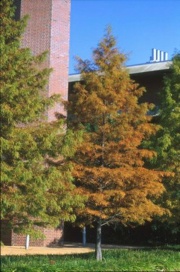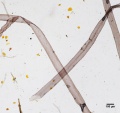Difference between revisions of "Bald cypress"
JMcGlinchey (talk | contribs) |
|||
| (2 intermediate revisions by 2 users not shown) | |||
| Line 1: | Line 1: | ||
| − | [[File:image 6-Bald cypress.jpg|thumb|Bald cypress | + | [[File:image 6-Bald cypress.jpg|thumb|Bald cypress (''Taxodium distichum'')]] |
| − | |||
| − | (''Taxodium distichum'')]] | ||
== Description == | == Description == | ||
A deciduous, softwood tree (''Taxodium distichum'') native to the wetlands of southeastern United States. The bald cypress produces of durable, decay resistant wood. The soft, lightweight wood is reddish-brown with a straight grain. It is often used for outdoor construction, roofing, fencing, flooring, and boat building. Because bald cypress timber is easily worked, it has also been used as an interior finish wood. The peak lumbering period for bald cypress was from 1870-1915 (Bucher 1996). When the bald cypress grows in a watery area, it has aerial roots called knees. The knees, because of their interesting shapes, have been used as souvenirs, art objects, and bases for flower arrangements. | A deciduous, softwood tree (''Taxodium distichum'') native to the wetlands of southeastern United States. The bald cypress produces of durable, decay resistant wood. The soft, lightweight wood is reddish-brown with a straight grain. It is often used for outdoor construction, roofing, fencing, flooring, and boat building. Because bald cypress timber is easily worked, it has also been used as an interior finish wood. The peak lumbering period for bald cypress was from 1870-1915 (Bucher 1996). When the bald cypress grows in a watery area, it has aerial roots called knees. The knees, because of their interesting shapes, have been used as souvenirs, art objects, and bases for flower arrangements. | ||
| − | [[File:06_TidewaterRedCypress.jpg|thumb|Tidewater Red Cypress | + | [[File:06_TidewaterRedCypress.jpg|thumb|Tidewater Red Cypress (''Taxodium distichum'')]] |
| − | |||
| − | (''Taxodium distichum'')]] | ||
== Synonyms and Related Terms == | == Synonyms and Related Terms == | ||
''Taxodium distichum''; cyprès chauve (Fr.); ciprés de los pantanos (Esp.); cipresso calvo (It.); taxódio (Port.); southern cypress; swamp cypress; pond cypress; deciduous cypress; tidewater red cypress | ''Taxodium distichum''; cyprès chauve (Fr.); ciprés de los pantanos (Esp.); cipresso calvo (It.); taxódio (Port.); southern cypress; swamp cypress; pond cypress; deciduous cypress; tidewater red cypress | ||
| + | ==Physical and Chemical Properties== | ||
| + | * Density = 32 pcf | ||
| − | |||
| − | |||
| − | |||
| − | |||
| − | |||
| − | |||
| − | |||
Paper fiber type: Softwood. Using transmitted light microscopy, fibers are identified by the presence of taxodiod and cupressiod ray parenchyma pits, 2-4 across. Fibers are wide and can be up to 7mm long. Appearance with [[Graff "C" stain]]: varies with bleaching. Average dimensions of fibers: 6.2mm, av width 45-60μm. Common pulping method: [[sulfite process|sulfite]] or [[kraft process|kraft]]. | Paper fiber type: Softwood. Using transmitted light microscopy, fibers are identified by the presence of taxodiod and cupressiod ray parenchyma pits, 2-4 across. Fibers are wide and can be up to 7mm long. Appearance with [[Graff "C" stain]]: varies with bleaching. Average dimensions of fibers: 6.2mm, av width 45-60μm. Common pulping method: [[sulfite process|sulfite]] or [[kraft process|kraft]]. | ||
| − | |||
| − | |||
| − | |||
| − | |||
== Additional Images == | == Additional Images == | ||
<gallery> | <gallery> | ||
| − | File:26_Bald Cypress_100x_Rad.jpg|Bald cypress (''Taxodium distichum'') | + | File:26_Bald Cypress_100x_Rad.jpg|Bald cypress (''Taxodium distichum'')<br> radial section |
| − | File:26_Bald Cypress_100x_Tran.jpg|Bald cypress (''Taxodium distichum'') | + | File:26_Bald Cypress_100x_Tran.jpg|Bald cypress (''Taxodium distichum'')<br> transverse section |
| − | File:Baldcypress 40x 5.jpg|Bald cypress paper pulp | + | File:Baldcypress 40x 5.jpg|Bald cypress paper pulp at 40x |
| − | File:Baldcypress 10x pits.jpg|Bald cypress paper pulp | + | File:Baldcypress 10x pits.jpg|Bald cypress paper pulp pits at 10x |
</gallery> | </gallery> | ||
| − | == | + | ==Resources and Citations== |
* G.S.Brady, ''Materials Handbook'', McGraw-Hill Book Co., New York, 1971 Comment: p. 258 | * G.S.Brady, ''Materials Handbook'', McGraw-Hill Book Co., New York, 1971 Comment: p. 258 | ||
| Line 45: | Line 32: | ||
* Random House, ''Webster's Encyclopedic Unabridged Dictionary of the English Language'', Grammercy Book, New York, 1997 | * Random House, ''Webster's Encyclopedic Unabridged Dictionary of the English Language'', Grammercy Book, New York, 1997 | ||
| − | * | + | * Southern Cypress Manufacturers Association, Jacksonville, Fla.: air-dry weight = 32 pcf |
* ''The American Heritage Dictionary'' or ''Encarta'', via Microsoft Bookshelf 98, Microsoft Corp., 1998 | * ''The American Heritage Dictionary'' or ''Encarta'', via Microsoft Bookshelf 98, Microsoft Corp., 1998 | ||
| + | * Marja-Sisko Ilvessalo-Pfäffli. ''Fiber Atlas: Identification of Papermaking Fibers'' (Springer Series in Wood Science). Springer, 1995. | ||
| + | * Walter Rantanen. "Fiber ID Course." Integrated Paper Services. June 2013. Lecture. | ||
[[Category:Materials database]] | [[Category:Materials database]] | ||
Latest revision as of 16:17, 1 May 2022
Description
A deciduous, softwood tree (Taxodium distichum) native to the wetlands of southeastern United States. The bald cypress produces of durable, decay resistant wood. The soft, lightweight wood is reddish-brown with a straight grain. It is often used for outdoor construction, roofing, fencing, flooring, and boat building. Because bald cypress timber is easily worked, it has also been used as an interior finish wood. The peak lumbering period for bald cypress was from 1870-1915 (Bucher 1996). When the bald cypress grows in a watery area, it has aerial roots called knees. The knees, because of their interesting shapes, have been used as souvenirs, art objects, and bases for flower arrangements.
Synonyms and Related Terms
Taxodium distichum; cyprès chauve (Fr.); ciprés de los pantanos (Esp.); cipresso calvo (It.); taxódio (Port.); southern cypress; swamp cypress; pond cypress; deciduous cypress; tidewater red cypress
Physical and Chemical Properties
- Density = 32 pcf
Paper fiber type: Softwood. Using transmitted light microscopy, fibers are identified by the presence of taxodiod and cupressiod ray parenchyma pits, 2-4 across. Fibers are wide and can be up to 7mm long. Appearance with Graff "C" stain: varies with bleaching. Average dimensions of fibers: 6.2mm, av width 45-60μm. Common pulping method: sulfite or kraft.
Additional Images
Resources and Citations
- G.S.Brady, Materials Handbook, McGraw-Hill Book Co., New York, 1971 Comment: p. 258
- Dictionary of Building Preservation, Ward Bucher, ed., John Wiley & Sons, Inc., New York City, 1996
- Van Nostrand's Scientific Encyclopedia, Douglas M. Considine (ed.), Van Nostrand Reinhold, New York, 1976
- Random House, Webster's Encyclopedic Unabridged Dictionary of the English Language, Grammercy Book, New York, 1997
- Southern Cypress Manufacturers Association, Jacksonville, Fla.: air-dry weight = 32 pcf
- The American Heritage Dictionary or Encarta, via Microsoft Bookshelf 98, Microsoft Corp., 1998
- Marja-Sisko Ilvessalo-Pfäffli. Fiber Atlas: Identification of Papermaking Fibers (Springer Series in Wood Science). Springer, 1995.
- Walter Rantanen. "Fiber ID Course." Integrated Paper Services. June 2013. Lecture.





